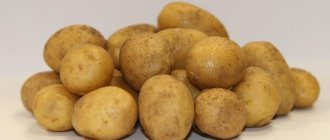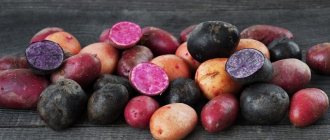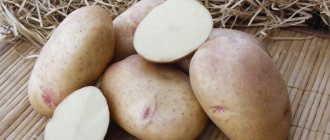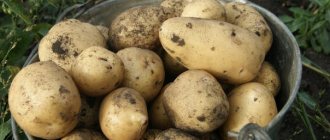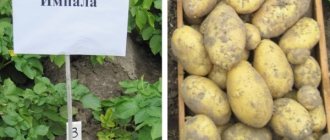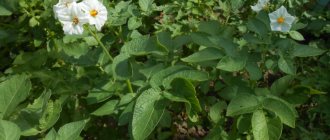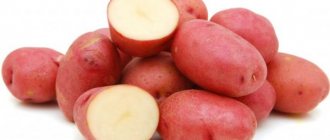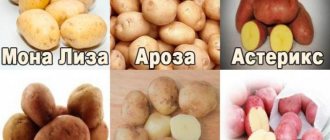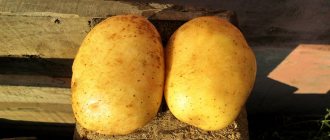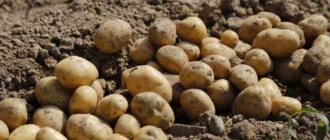Chugunka potatoes - what kind of variety are they?
Chugunka potatoes, whose characteristics are extremely positive, have many adherents. The culture has won people's love over the past 5 years.
The vegetable gained popularity due to its high yield, ease of care and bright taste.
Ripening time and yield
Purple potatoes are considered early ripening. After 70 days you can start harvesting. In some cases, the growing season is 60 days, but much depends on climatic conditions.
Many people buy tubers precisely because of their appearance.
For your information! The variety is considered to be quite resistant to diseases common to such a vegetable, so even an amateur can harvest a decent harvest.
Characteristics of tubers
Purple Chugunka potatoes have the following external distinctive features:
- bushes can reach 70 cm in height. The stems are smooth and located vertically to the ground almost the entire growing season;
- The crown of the stems is lush. The leaves are dark green in color with carved edges, they are fleecy to the touch;
- the bush usually has a powerful root system that penetrates deep to extract nutrients;
- one unit forms approximately 10 medium-sized tubers. The skin of the potato is purple in color. The shape of the tubers is oblong and the size is larger than average.
Features of the species is its unusual color
Many summer residents plant this particular variety due to its non-standard characteristics.
What regions is it suitable for?
Colored potatoes love temperate climates. In regions with more severe weather conditions, the yield level and quality of tubers are not good. In the southern regions, you can reap a generous harvest with careful care, specifically watering.
Taste qualities
Tubers of the Chugunka variety have a pleasant taste, which has rich notes. They make an airy white puree.
For your information! It takes 10-15 minutes for the dish to be fully cooked. boiling.
Additionally, potatoes can be fried, stewed, baked or stuffed. Gourmets will appreciate the taste qualities of this variety.
Characteristics and description of the variety
An early-ripening, drought-resistant variety attracts the attention of gardeners both in appearance and in its productive characteristics.
Description of the bush and root crops
The bush is compact in shape, from 50 cm to 70 cm in height, with a powerful root system. Stems are strong, straight, leafy. The leaf blades are dark green, mottled with veins, and the edge of the leaf is wavy. During flowering, it forms a corolla of lilac-violet baskets.
Tubers with smooth and even skin, without dents, weighing 100–130 g. The shape of the potato is an elongated oval, the skin color is purple. The pulp is white-yellow, possibly with purple spots. Used as a table variety, it has an excellent taste, an average amount of starch up to 17%.
Productivity
From the emergence of seedlings to ripening, 70–75 days pass. 6–10 potatoes are tied under each bush. On poor soils the yield averages about 100 c/ha, on nutritious or enriched soils up to 200 c/ha.
Disease resistance
The variety is highly resistant to viral diseases, bacterial rot (including root collar), and cancer. It is rarely affected by late blight and beetles (click beetle, wireworm, Colorado potato).
Did you know? The painting “The Potato Eaters” by the Dutch artist Van Gogh is considered one of his darkest masterpieces. It still evokes conflicting reviews from critics and ordinary people.
The main advantages and disadvantages of the variety
The variety is becoming increasingly popular among summer residents, as it has many positive qualities. Potato benefits:
- deep, but at the same time soft taste;
- the pulp remains light during the cleaning and cooking process for a long time;
- simultaneous precocity;
- can be stored for a long time and not deteriorate;
- easy to care for;
- resistant to drought and many diseases.
The fruits of this variety can be stored for a long time and do not spoil
Note! Chugunka is considered a high-yielding variety. From 1 hectare you can harvest more than 150 kg of crop.
In contrast to the positive qualities are two disadvantages. The soil must be saturated with nutrients. Before each planting season, you need to update the material.
How to cook “Chicken in cast iron with potatoes”
Prepare your ingredients. Cut the chicken into pieces; if you have thighs, it is better to cut the meat off the bone. Peel the vegetables and cut them fairly large. Preheat the oven to 190 degrees.
Pour corn oil into the bottom of the cast iron, then add carrots, eggplants and chicken.
Then add coarsely chopped onion and garlic. Top with potatoes and a couple of tablespoons of melted butter. Place everything in the oven, covered with foil.
Bake until done, about an hour, checking for doneness as you go. You can turn down the heat. Serve the finished chicken in a cast iron with potatoes with vegetables. Bon appetit!
Planting and growing Chugunka potatoes
The lilac variety has its own requirements for planting and growing, which are not particularly difficult. You need to follow these points:
- Prepare planting material.
- Choose suitable soil.
- Determine the optimal time for disembarkation.
- Land in accordance with certain rules.
Tubers should be planted according to a specific algorithm to achieve a high yield.
Preparing potatoes for planting and planting themselves are the most important stages that require special attention.
Preparing for landing
A month before planting, you need to prepare the potatoes - select healthy medium-sized tubers. Selected planting material should be treated with an antiseptic, dried in the sun and placed in a warm and well-lit place.
Important! To increase productivity, it is worth spraying the tubers with a growth stimulator during the preparation period. After 1-2 weeks, you can evaluate the quality of the emerging sprouts.
Soil requirements
Experienced summer residents claim that the soil in the area where potatoes will be planted can be anything. In fact, this is true. But in soil poor in nutrients, the yield will be low, and the size of the tubers will be no larger than average. Additionally, cases of individual bushes becoming infected with phytosporosis will become more frequent. In more nutritious soil, the quantity and quality of tubers will exceed all expectations.
Dates, scheme and rules of planting
The variety should be planted in mid-May. But you need to carefully monitor the degree of soil warming. If the spring weather is warm enough throughout April, then the planting date can be moved closer to the beginning of May.
The potatoes are laid out at a distance of 30 cm from each other. The row spacing should be 60 cm. Deepen the tubers by 10-12 cm.
Characteristics, description, yield, reviews and photos of the “Chugunka” potato variety
“Chugunka” is a rather interesting potato variety.
It differs from others with its elegant bluish-purple tubers. And the yield will depend on the soil and climatic conditions in which the root crop is grown. FOR REFERENCE: This type of potato is recommended to be grown for personal purposes, in small farms. This variety cannot be used on an industrial scale.
The Chugunka variety will be the most striking example of folk selection. Although it is not included in the State Register of the Russian Federation, it is actively used by amateur gardeners.
It should be borne in mind that when using the same planting material for a long time, potatoes degenerate. To get a good harvest, it is worth periodically updating the tubers for planting.
Popular potato varieties:
“Chugunka” is an early-ripening table variety that is resistant to drought, but the yield is low. So from one hectare they get only 200 centners. starch ranges from 10-17%.
From one bush you can get from 6 to 11 tubers weighing up to 130 g.
The skin color is bluish-violet, the flesh is cream or white. “Cast iron” is well preserved and resistant to many diseases.
The table below presents data on the yield of other potato varieties:
| Name | Variety | Productivity |
| Nikulinsky | Late ripening | From 170 to 300 centners per hectare. |
| Cardinal | Late ripening | From 200 to 350 centners of potatoes are harvested from 1 hectare. |
| Rocco | Late ripening | From 350 to 400 centners per hectare. |
| Kiwi | Late ripening | From 1 kg of planting tubers it reaches 20 kg. |
| Picasso | Late ripening | From 1 hectare about 20 tons. |
| Borovichok | Early ripening | 200-250 centners per 1 hectare of land. |
| Elmundo | Early ripening | 250-350 centners per hectare. |
| Felox | Early ripening | 250 centners per hectare. |
| Bellarosa | Early ripening | The harvest from one bush is 8-10 tubers. |
| Natasha | Early ripening | From 130 to 190 centners per hectare. |
| Forty days | Extra early | Up to 300 centners of potatoes are harvested from one hectare of soil. |
| Karatop | Extra early | From 18.5 to 27 tons per hectare (Middle Volga region), from 20 to 43.5 tons per hectare (Northwestern region). The maximum yield is 50 tons per hectare. |
| Riviera | Extra early | After the first digging on the 45th day after the emergence of potato shoots, it ranges from 134 to 225 centners per hectare. The maximum yield by the end of the growing season reaches 450 centners per hectare. |
| Zhukovsky early | Extra early | The harvest from one bush is up to 15 tubers. |
| Minerva | Extra early | Fertile soils allow you to harvest the first harvest of up to 230 centners per hectare. By the end of the growing season (45-50 days), the maximum yield is achieved - up to 430 centners per hectare. |
| Crane | Mid-late | 640 centners per hectare. |
| Sorcerer | Mid-late | Productivity varies from 27 to 35 tons per hectare. |
| Mozart | Mid-late | The average yield is approximately 430 c/ha. |
| Grenada | Mid-late | From one hectare you can harvest up to 60 tons of potatoes. |
| Ramona | Mid-late | The yield is consistently average from 10 to 15 tons per hectare. |
| Yanka | Mid-early | The average yield ranges from 195 to 315 centners per hectare. |
| Giant | Mid-early | The average harvest ranges from 290 to 424 centners per hectare. |
| Tuscany | Mid-early | Productivity varies from 210 to 400 centners per hectare. |
| Purple Haze | Mid-early | Productivity varies from 182 to 309 centners per hectare. |
| Santana | Mid-early | The average yield varies from 164 to 384 centners per hectare. |
Advantages and disadvantages
Among the positive aspects are the following:
- Early maturation;
- Pleasant taste;
- Drought resistance;
IMPORTANT: Among the advantages, gardeners also name high shelf life.
- Low maintenance requirements;
- Immunity to many diseases.
However, there are also disadvantages:
- Sensitivity to nutrient soils;
- The need to update material after a certain time.
Peculiarities
What sets this variety apart from others is that its yield will depend on the nutritional value of the soil and climatic conditions. The warmer the weather and richer the soil, the more potatoes you can harvest.
Correct fit
Planting in open ground begins only when the ground is well warmed up and sufficiently moistened. "Chugunka" prefers light soils, but can also grow on loams. The tubers are buried 10-12 cm.
Before planting, the soil can be fertilized with wood ash or humus.
REMEMBER: Before planting, planting material is prepared and kept in a bright place, in damp sawdust.
For this variety, standard agrotechnical practices will be mandatory, on which the marketable appearance of the potato depends. So, “Caugunka” needs to be weeded and hilled in time, forming high ridges. Water the root crop only during dry summers.
ATTENTION: Once during the growth period, the bushes can be fed with mineral fertilizers or organic matter.
“Cast iron” can only be affected by late blight of greens and tubers, so preventive measures should be taken first.
Typically, potatoes are very fond of Colorado potato beetles and wireworms, but this variety is a happy exception.
We invite you to familiarize yourself with potato varieties that have different ripening periods:
Harvesting
The ripening period for “Chugunka” is 70-75 days. It is after this period that potatoes can be harvested manually or using special mechanisms.
Potato varieties:
Reviews about the variety
“Chugunka” is a very interesting variety. Gardeners value it for its smooth, large tubers and low maintenance requirements. These potatoes also have a pleasant taste; the flesh does not darken during cutting. They also note the high content of antioxidants, vitamins and other beneficial substances in this root vegetable.
We recommend articles on the topic
3
0
Source: https://web-selo.ru/sort-kartofelya-chugunka-harakteristika-opisanie-urozhajnost-otzyvy-i-foto.html
How to properly care for the variety
The Chugunka potato variety does not require much attention. It is enough to water at the right time, carry out pest control, fertilize and hill up the bushes. All this must be done in a timely manner.
You can fertilize potatoes with wood ash
Features of watering
The irrigation regime should be set only during drought periods. If it rains a little at least once a week, then this is enough for the variety. Also, during the rainy season, it is worth adding ash under the bushes to prevent the appearance of gray rot.
Feeding and fertilizing
You should not use any special chemical fertilizers. The best option would be organic fertilizers - mullein, rotted leaves, rotten remains of vegetables and fruits. One feeding in the middle of the growing season is enough.
Hilling and weeding
During the growing process, hilling is carried out 1-2 times per season. Using a plow, a high ridge is formed.
Hilling of bushes must be carried out three times per season.
At the time of hilling, all weeds must be removed. Mulching the rows with straw or mown grass will help make the process easier. But this is done after hilling.
Diseases and pests: how to fight
Potatoes also have their weaknesses. More often, bushes can be affected by late blight (lack of iron). To restore the iron balance, it is worth treating the above-ground part with copper sulfate.
Ready-made potatoes are the result of a gardener’s painstaking work
Like any other type of potato, Chugunka is loved by Colorado potato beetles. Special preparations are used to combat these pests.
If we consider the description of this potato variety, it will seem that the crop simply has no shortcomings. In fact, there are some nuances regarding care and planting. If you take everything into account, the harvest will be impressive, and its storage until spring will cost no losses.
How to harvest and store crops
It is important to dig up potatoes correctly and in a timely manner. Additionally, in order for the vegetable to be preserved until spring, you need to create the right storage conditions. There should not be any special problems with installation and storage.
Storage features and keeping quality of the Chugunka variety
The quality of potatoes is confirmed by their long normal storage period. If the room temperature is within 5-9 °C, and the humidity is at least 60%, then half of the conditions have already been met. Additionally, you need to reduce the degree of illumination; it is advisable to lay the tubers on dry grass.
